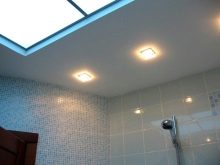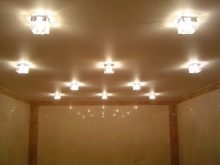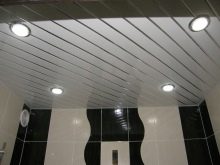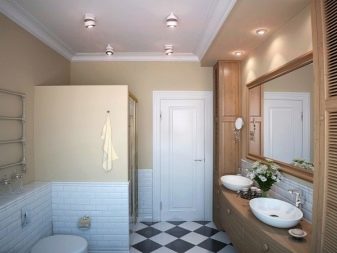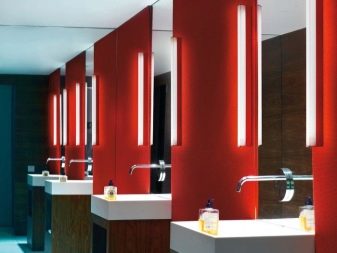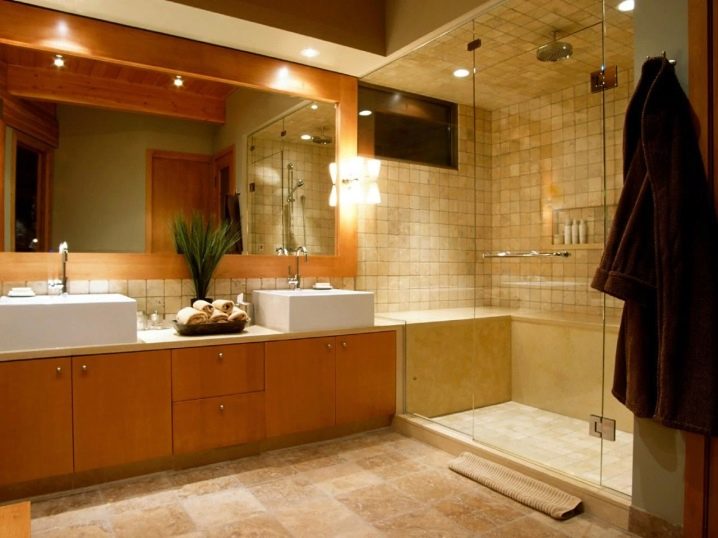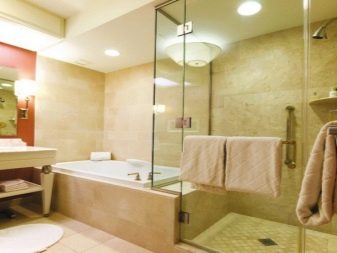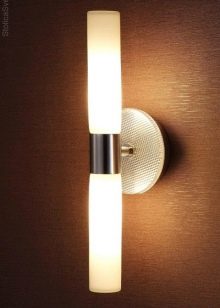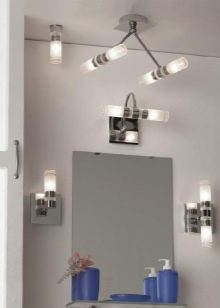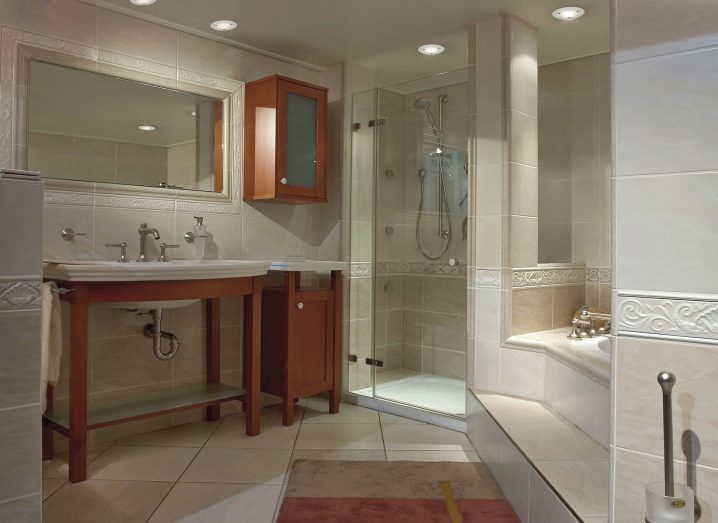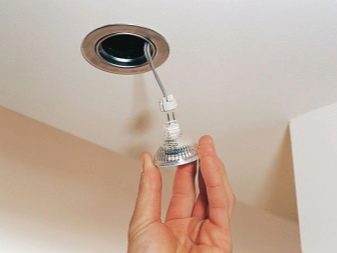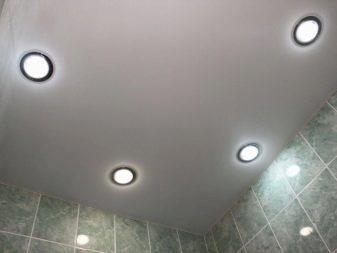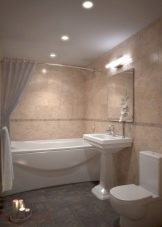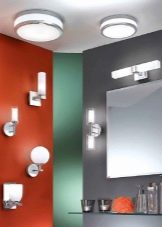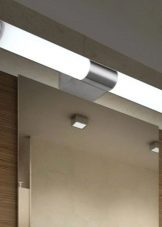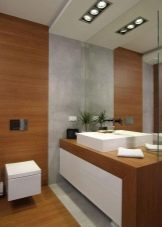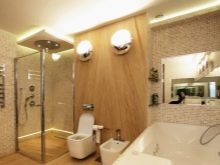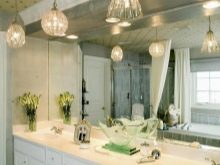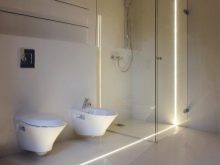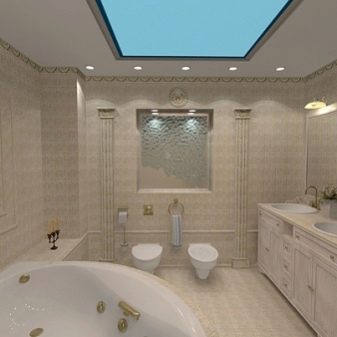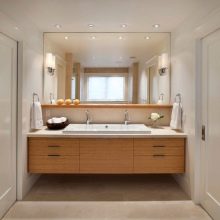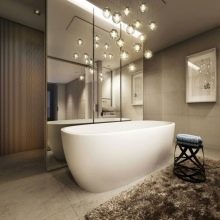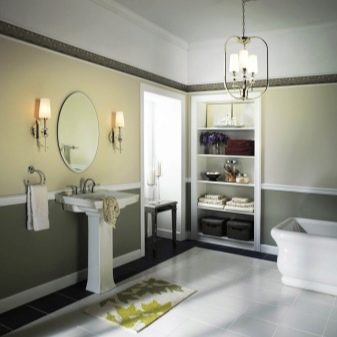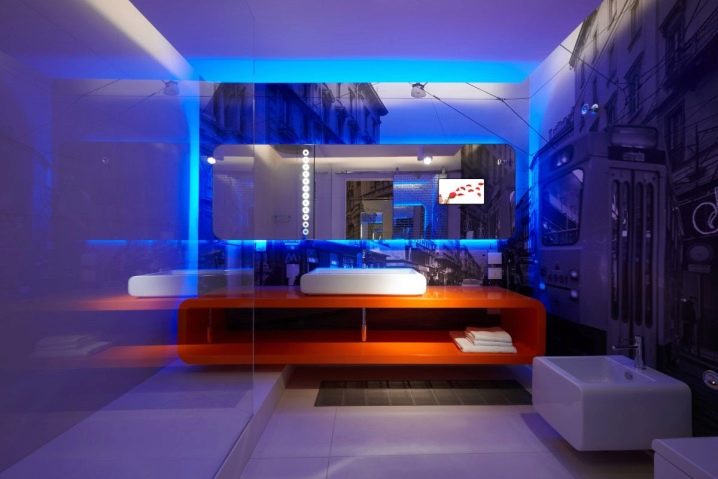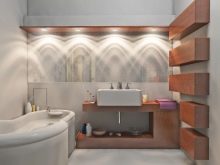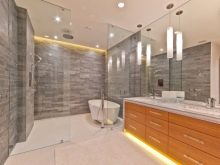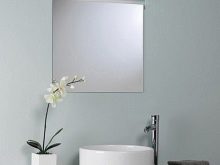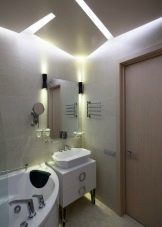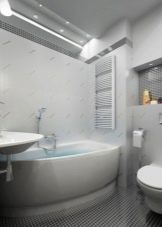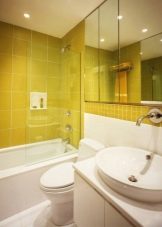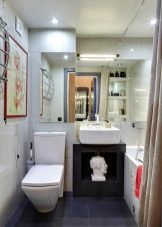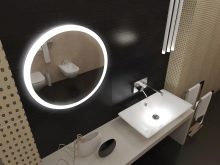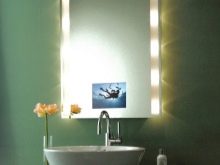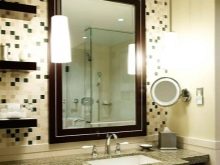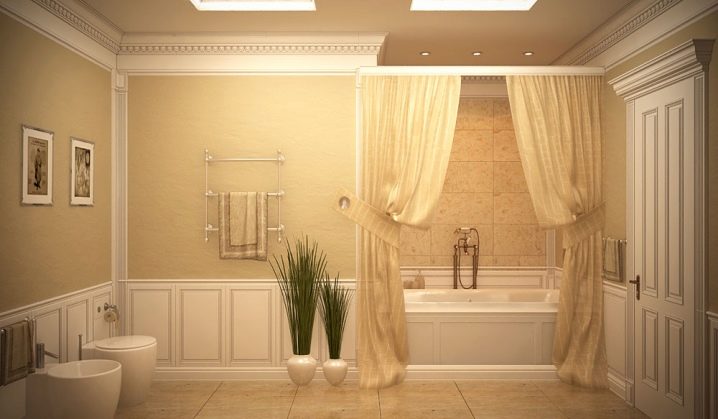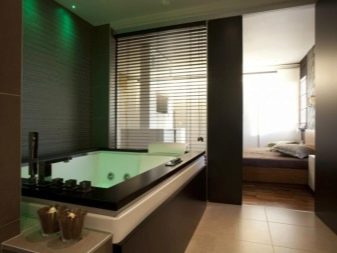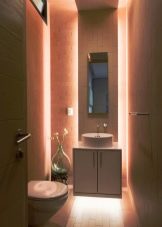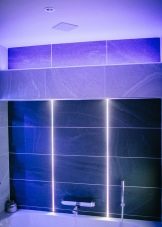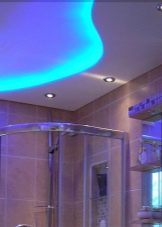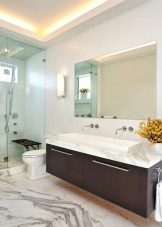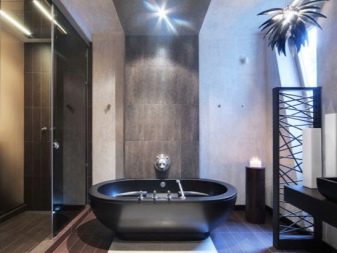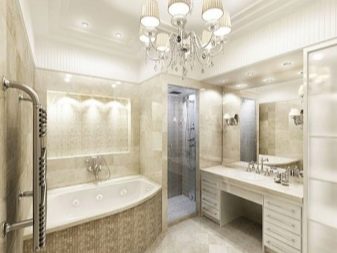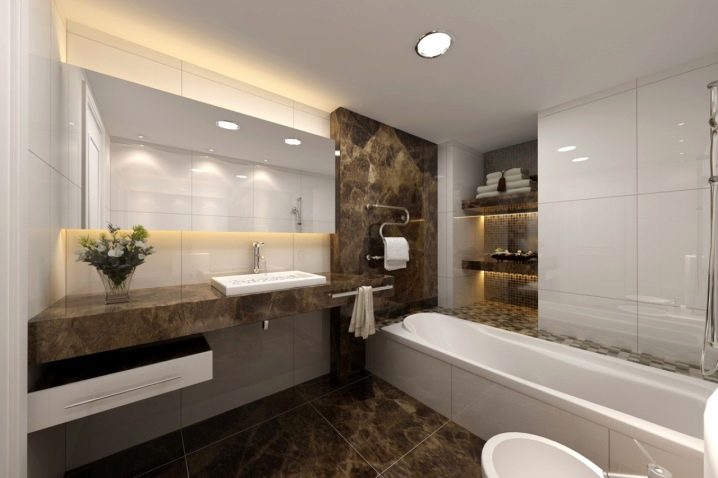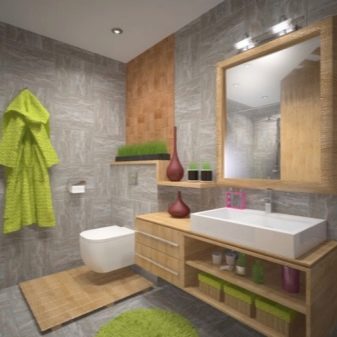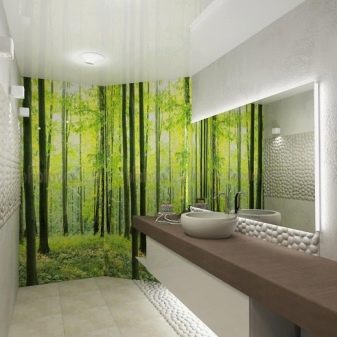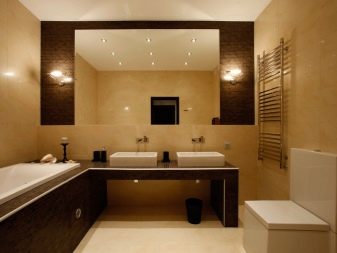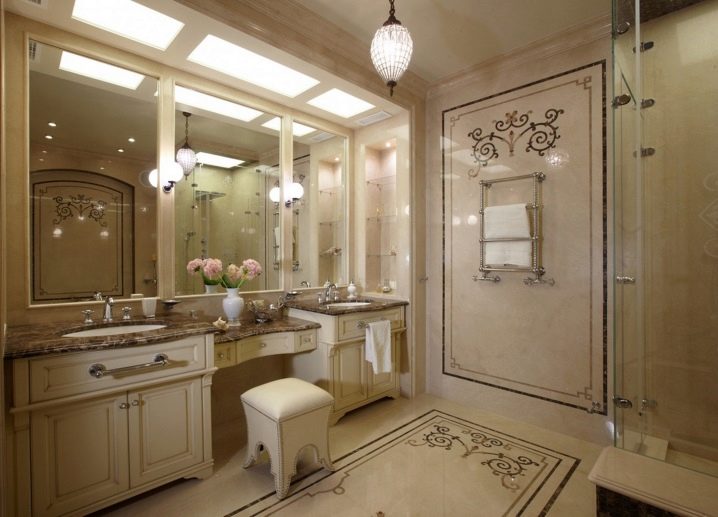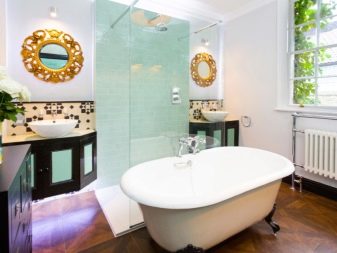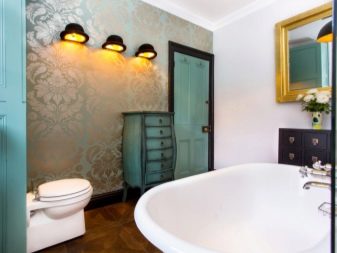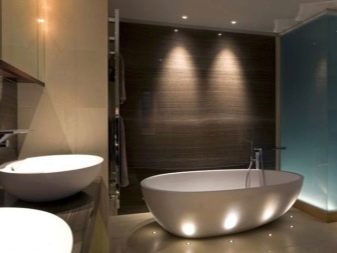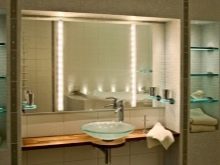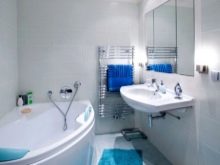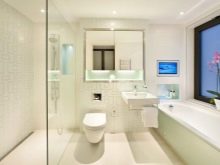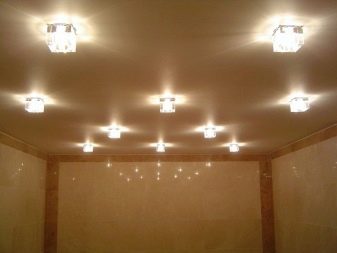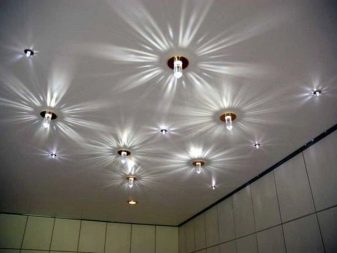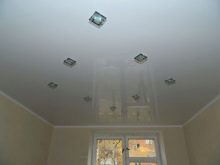Spotlights in the bathroom
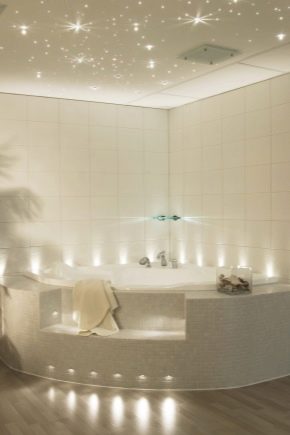
When planning repairs in the bathroom, many are faced with a difficult choice of artificial lighting in the complete absence of natural. In the modern market of various electrical devices, spotlights are becoming more and more popular, because, due to their unique characteristics, they are able to perform several important functions at the same time, as well as meet important parameters: compactness, brightness, moisture resistance.
What are they?
Spotlights are small devices (fluorescent or halogen lamps),which, due to their special frame, are mounted in false ceilings, allowing to provide sufficient luminous flux to illuminate the bathroom. The specially equipped case maximally protects the built-in lamps from ingress of moisture and significantly reduces the risk of a short circuit. Due to its design, these sources give the interior a harmonious, aesthetic look.
Particularly popular products from several countries: Germany, Britain, Italy, Spain. These are mainly halogen lamps. Domestic manufacturers prefer models with incandescent bulbs, which, not much different in design, are much lower in cost.
What to choose and how to replace?
Advantages of halogen lamps:
- acceptable price;
- large light output;
- continuous operation.
Due to the release of a large amount of heat, the installation of these devices is used only in suspended and suspended ceilings.
LED samples (called LEDs), which are based on light-emitting diodes.
At the moment, it is one of the most common species that have several advantages:
- long-term operation (up to 50,000 hours of work);
- high luminous efficiency;
- they emit white light, which has a beneficial effect on vision;
- low power consumption.
But these undoubted advantages can not hide some of the shortcomings:
- high cost (4-5 times more expensive than similar models with other light sources);
- difficult installation exclusively through a transformer.
Despite the disadvantages, these samples are now in great demand because they have many modifications of cartridges for both standard bulbs (E27) and other types (E14, the so-called G4, G5, G9 minions).
Incandescent lamps. This species also received its customers, who prefer a low price, practicality and ease of use. Consumers use the stereotype that has developed for a long time using just such electric appliances and has become a kind of habit.
But do not lose sight of the present cons:
- small resource;
- short service life.
External characteristics are also very important when choosing lamps in the bathroom room. In any specialized store you can choose a model for every taste and color, which will be in harmony with any interior.
In the bathroom, you must use special waterproof lamps.
Not every buyer at a glance will be able to distinguish a standard device from a moisture resistant. The special marking of the goods with the letters IP indicates that the electrical device is protected against moisture. And the numbers that follow, show the degree of protection (IP44 - from accidental splashes, IP55 - from direct contact with a stream of water) - the higher the IP index, the safer the appliance. In such luminaires, the connection holes and the gap between the glass and the lamp itself are equipped with reliable rubber gaskets.
Moisture-proof devices are performed as follows:
- completely buried in the ceiling;
- stand down;
- have the shape of a ceiling;
- can combine decorative details and design in color.
The source projecting above the ceiling gives more light, reflecting from the lamp to the ceiling, rushes down.
How to make mounting spotlights yourself see in the next video.
Is it possible to replace the lamp in the device?
For point lighting, two types of basement are used, as a rule:
- with a normal right-hand thread for a standard cartridge.Replacing such a light bulb will not be difficult;
- lamps with base type G and its modifications, which for mounting have two pins, guides and fixing the installation. When replacing such an aggregate, do not use force. When the pins hit the groove, a distinctive click will occur, indicating that a snap has occurred. If this does not happen, do not try to push, try again, pulling an element that most likely did not fall into the groove.
There are other sources where it is impossible to replace the lamp built into the lamp itself. In case of failure, you will have to change the entire lighting fixture. And for this it is better to contact an expert on the installation of these types.
Species
Lighting devices according to similar principles are divided into types:
- By way of installation: internal (or built-in) and external (or overhead, otherwise spots). Recessed (have a metal case with fixing elements for the lamp) are mounted in any surface under which there is a free space: suspended or suspended ceilings, plasterboard structures, walls, cabinets. LED diodes are commonly used.
Overhead or spot (have a mounting platform, which is attached to the light housing) are placed on solid ceilings or concrete ceilings, where there is no possibility to make recesses for installing internal models. They are designed to illuminate a specific area of the room and have a directed luminous flux. Usually they are installed at the mirror.
- By location: ceiling, floor, wall. Ceiling models are especially common in modern bathrooms. Located at a fairly high altitude, they are as safe as possible to use. Can be equipped with a moving mechanism (turning) for independent selection of the direction of illumination. The latest design developments allow to embed some models in the flooring, creating a unique effect, especially in the floor with a decoration in the style of 3D.
- By using different types of light bulbs inside a certain model (as detailed above).
- According to the materialof which they are made: glass, crystal, cast, stamped. Specialists for installation in PVC stretch ceilings (limiting the power of a 35 W halogen lamp) recommend choosing stamped ones, because they have a place to insert a special thermal ring,which practically does not heat up. But it will be noticeable when installing cast samples, which significantly spoil the aesthetic perception.
- By device type: pivoting (allow you to change the direction of light by turning a special socket) and fixed or not swiveling (which are firmly attached to the ceiling and their flow of light is fixed in one place).
Separately, I would like to note dimmed (or dimmable) LED lamps, which allow you to change the power of the luminous flux through the use of an additional built-in unit (dimmer). With the help of dimmer, the illumination can vary from ten to one hundred percent.
Such sources allow you to create a cozy and unusual atmosphere in the house.
The only drawback of these structures is the high enough price, so how practical it will be to acquire such an option is up to you.
Purpose
Wall options
In addition to the widely used ceiling lighting, in recent times single wall lamps in the form of sconces have become increasingly used. They contain a few light bulbs, but at the same time perform the function of decor and look great, emphasizing our view on the spectacular decoration.A sufficiently large ceiling in the form of a ball, which is securely attached to the wall with screws, will also be suitable as a wall model. The main thing that he approached the design and had sufficient brightness.
The mirror in the bathroom plays an important role, and therefore requires a separate light. And here the most convenient will be the wall version, which can be in the form of several built-in spotlights or led strip running around the perimeter.
Ideas in the "Khrushchev"
Even a small bathroom in the "Khrushchev" will play with new colors with optimally selected lamps that will create a certain visual illusion, expand the room and hide the flaws or accentuate the highlights of the interior.
Bright lighting can "push" the walls, and designers are advised to resort to diverse lighting with dimmed LED lamps that can regulate the power of the light flux.
In the morning, they can be turned on to the maximum brightness to help the body wake up, and in the evening - to reduce the intensity of illumination in order to prepare for the evening rest and sleep.
In a small bathroom, functional areas are highlighted with light:
- the easiest way is to focus on each item;
- select a particular object with a beam of light that is collected from different places;
- Illuminate different zones with color illumination. This can be achieved by installing several lamps of different colors on the ceiling and directing them to the right place;
- apply on-off sources for different zones (the color of the lamps may not coincide).
Proper mirror lighting also helps to beat the small bathroom section:
- choose uniform lighting with several horizontally placed lights at a height of about 1.5 - 2 meters;
- frame a small mirror with two symmetrical lamps that evenly distribute light without shadow transitions;
- pave lighting devices along the contour of the accessory;
- fixtures can be mounted both on the wall and on the glass itself with the help of special glue.
Styles
Each of us dreams that the dwelling, and, in particular, the bathroom, looked modern, well-groomed. It helps to gain inner satisfaction, aesthetic pleasure, is conducive to positive, helps to stay in a great mood:
- Considered the most popular classic style design, which implies restraint, elegance and a certain simplicity. Laconic versions of luminaires are acceptable here without excessive decoration, which can accentuate the beauty and elegance of the interior.
- Another attractive bathroom option can be made in style. Hіgh-tech (hi-tech). Lamps in this direction are made of glass, plastic, can have a variety of metal elements and a shiny surface that will favorably emphasize the style. But at the same time, the abundance of creative decor is also not typical. In shape, they can be round, in the form of a trapezoid and other figures.
Newest acquisition are LED strip. Such design will be appreciated not only by young people, but also by their contemporaries of the older generation, who are able to appreciate simplicity, elegance and elegance.
- The most fashionable direction of the 20s-30s of the last century - art deco style very popular today. His motto is geometry without asceticism. Typical are geometric shapes of regular shape: ball, cube, octahedron (or octahedron). Often these lamps are associated with the temples of the ancient Aztecs and the pyramids of the Egyptians.Installed, as a rule, in expensive hotels, luxury mansions, luxury restaurants.
- The brightest direction in design can be called modern (or ar nouveau). Expensive materials (quartz, marble, leather, natural wood, glass) and very smooth and curved lines are peculiar to the style. Sometimes used semi-precious stones and inlays. Each model is considered an exclusive handicraft, because ideally it is custom made and not intended for mass production.
- Style bionics It is based on the word "bio" and personifies harmony with nature. Forms are also borrowed from the environment: sea shells, images of leaves, honeycombs of bees, like insects.
- Style deconstruction as if it casts doubt on the laws of physics and ordinary forms, and will be of interest to lovers of virtual reality and computer technology. The emphasis is on the backlight, creating optical illusions. LED tape is widely used.
- Minimalism does not assume excessive jewelry and color variety. Gray and white are the main shades of this trend. Lamps should look very simple and easy, so they have a simple geometric shape and are often made of glass.
- Style "Irony" appeared at the end of the last century.Lightheadedness and humor appeared in the interior designs. Today, recessed fixtures in this area will fit perfectly into the nursery or bathroom.
- For style neoclassical characterized by luxury and solidity, which implies the presence of expensive materials: crystal, shiny elements of chromium. This direction has smooth lines and shapes.
- Eclecticism - one of the most popular in Russia, where they often do not adhere to any one direction. It implies mixing at once several styles, not limited to fantasy: bronze lamps, illuminated by LED tape, can look favorably in a modern bathroom.
This is not a complete list of all design options, because the division of point fixtures into styles is very conditional, since it is very difficult to determine the boundaries of one or the other direction.
Variants of the location of lamps in the interior
When you have decided on the type of lamp and the type of lamp, the question arises: how best to arrange the light sources, and how many of them are needed for this room? Proper placement is very important.
Must be taken into account:
- the area of the room (for a small bathroom you will need not such a number of lamps as for the hall or living room);
- zonal distribution;
- if there are windows, then their number and location;
- space design (in the room and in the bathroom the lamps will be placed quite differently).
If we consider that one point device is designed to illuminate 2 square meters. m, then a room of 20 square meters. m, they will need ten, and for the bathroom in 4 square meters. m - only two.
But these are only approximate calculations for orientation. If you install a greater number of lighting devices, then you will only get better, because they do not blind the eyes like chandeliers.
The most popular location options are:
- Circle or two semicircles.
- Oval.
- Crosswise.
- Rectangle.
- Arc (or arch).
- Wave.
- Triangle.
- Star.
- Chaotic.
All at the mercy of your taste and harmony with the interior design.
